The official name of the Kokoda Trail has been contested in Australia since Paul Keating became the first Australian Prime Miniser to visit the Kokoda plateau since the end of World War 11 on the 50th Anniversary of the Kokoda campaign in 1992.
This begs the question as to who owns the official naming rights.
- Do they belong to the Papuan Infantry Battalion which was awarded the Battle Honour ‘Kokoda Trail’ by the Commonwealth Battles Nomenclature Committee in 1953? or
- to the traditional owner of the land and independent sovereign nation, Papua New Guinea, who officially gazetted the name ‘Kokoda Trail’ in 1972? or
- to the custodians of political correctness in Canberra who seem to dislike the term ‘trail’ because of its American connation?
Background
Over the past three decades more than 65,000 Australians have trekked across the Kokoda Trail in Papua New Guinea. Most trekkers are motivated by the wartime history of the Kokoda campaign. This this has led to an array of books and television documentaries on the topic.
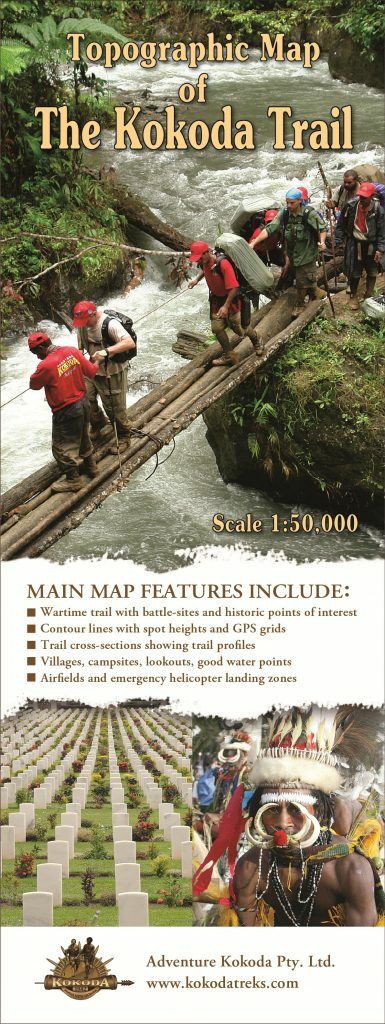
It has also led to some extensive debate about the official name of the trail.
Contemporary debate over the name evolved after former Australian Prime Minister Paul Keating kissed the ground at Kokoda on the 50th anniversary of the campaign and referred to the ‘Kokoda Trail’ in April 1992.
‘On the Kokoda Trail it was again the young and inexperienced militia men – this time of the 39th and 53rd battalions – later reinforced with soldiers of the 7th Division, who fought gallantly – and eventually won.’
Prime Minister Paul Keating
Port Moresby – 25 April 1992
This was accompanied by much ‘talkback’ noise about ‘trail’ being an American term and ‘track’ being the language of the Australian bush (ignoring the fact that our bush is criss-crossed with fire-trails). This suited Keating’s agenda for an Australian republic at the time.
The debate suited those in the Australian commentariat who harboured a strong anti-American bias over their engagement in Iraq around the time of the 60th anniversary of the Kokoda campaign. As most of the commentariat had never served in the regular armed forces they could be excused for not appreciating the esprit de corps associated with a battle honour. This, however, does not excuse them for ambushing a name that doesn’t reflect their political bias.
‘Kokoda Track’ has since emerged as the politically correct term in Australia in spite of the fact that the battle honour ‘Kokoda Trail’ was awarded to the Papuan Infantry Battalion and the 10 Australian battalions who fought in the Kokoda campaign and is the official name gazetted by the traditional owners of the land in 1972 i.e., the Government of Papua New Guinea.
Australian Battles Nomenclature Committee
Immediately after the war against Japan the Australian Government established a Battles Nomenclature Committee to define the battles of the Pacific.
According to research conducted by Peter Provis[i] at the Australian War Memorial the committee conferred with official historians ‘including Dudley McCarthy. He reported:
‘The Battles Nomenclature Committee used the ‘Battle of the Owen Stanley’s’ in a provisional list of battles, actions and engagements of the war in the South West Pacific Area produced in May 1947. For the preparation of the final list, Warren Perry, Assistant Director, wrote that the geographic boundaries required further work with ‘very detailed research into the original day to day records of the various campaigns’. The Committee may have deemed that the ‘Battle of the Owen Stanley’s covered a too broader area to describe the Kokoda campaign, suggesting that fighting occurred across the entire range. In June 1949 the provisional list of battles used ‘Kokoda Trail’.
‘The final report, completed and published in 1958, listed the ‘Kokoda Trail’ as the name of the battle, which included the actions Isurava, Ioribaiwa, Eora Creek-Templeton’s Crossing 11 and Oivi-Gorari as well as the following engagements: Kokoda-Deniki, Eora Creek-Templeton’s Crossing 1 and Efogi-Menari.’
Traditional Significance of a Regimental Battle Honour
In days of yore, according to Major Chad Sherrin MM, the King’s/Queen’s and Regimental Colours were carried into battle and it was of great shame to a unit and its men if the Colour should fall into the hands of the enemy; the term “Rally round the Colours’, with which some may be familiar, originates from this time when, if all else looked lost, the troops would rally round the colours to protect them and fight to the death if necessary. On the Regimental Colour is emblazoned the ‘battle honours’ of the unit – the unit’s proud ‘battle history’ and the source of much of the esprit de corps within the unit!
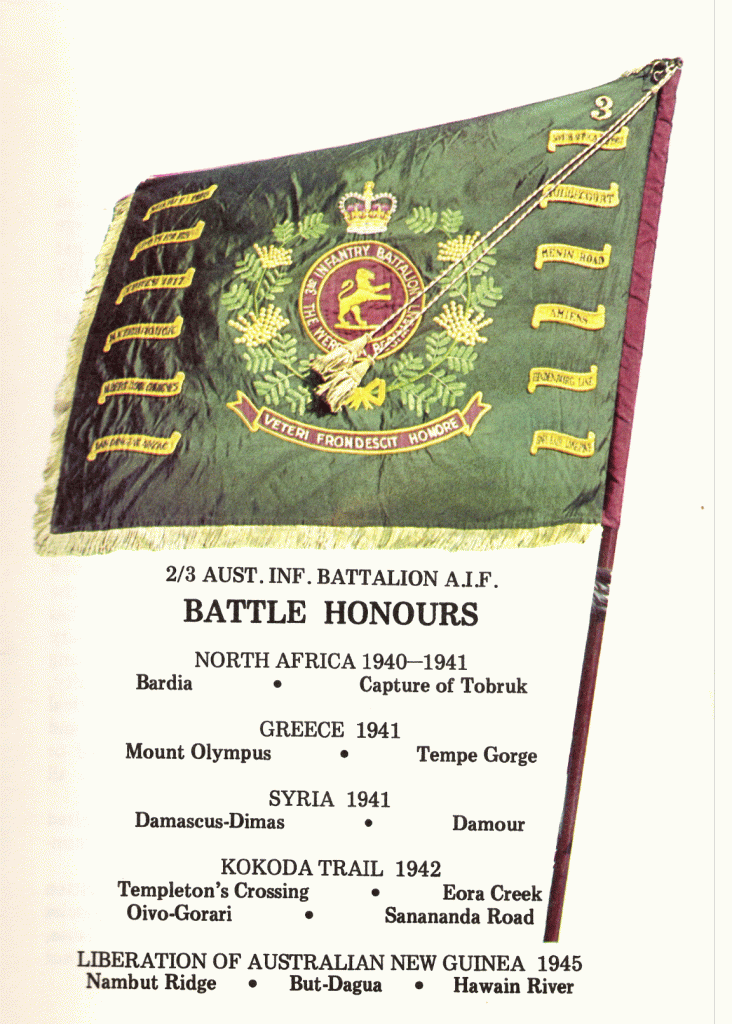
Today, while the Colours are no longer carried into battle, they remain an object of almost sacred reverence within a unit: still issued by the monarch, or her/his representative; consecrated by the Army’s senior chaplains prior to being handed to the unit; kept under lock and key within the unit; never handled with bare hands; carried on all ceremonial occasions and protected by a guard, with bayonets fixed; and saluted as they pass, by even the highest ranking officer in the Defence Force; all in recognition of the men who have fought and died under those Colours.
After each conflict in which our country has been involved, the battle honours to be awarded to a unit are decided by the Battles Nomenclature Committee. This committee deliberates for some time (years), and consults widely amongst units involved, before deciding the significant battle/s, and the name/s thereof, to be accorded as ‘battle honours’ and awarded to a unit. The battle honours awarded by that committee to each of the Australian units that fought in the Kokoda Campaign, and the Papua Infantry Battalion (PIB), is “Kokoda Trail”, and for the 39th Battalion and the PIB, the additional honour “Kokoda”.
John Hodgson, former Officer Commanding, C Coy, 3rd Battalion, Royal New South Wales Regiment (RNSWR) added: ‘Battalion and Regimental Colours have a life, eventually where the silk and satin fabric starts showing its age and use. At that stage, they are returned to the Regimental Church with great ceremony and laid up in the church, until they crumble to dust. As a young subaltern or sergeant, it was a great honour to be selected for the Colour Party, whenever the Colours were paraded for any occasion, even if only for a Regimental Dinner.
In the 3rd Battalion, RNSWR, we were very proud of the KOKODA TRAIL honour we had custody of. Having grown up in Port Moresby, I had even a greater respect for what 39th and 3rd Battalions endured.’
As the custodians of our military heritage, the DVA and the AWM, above all others, and in spite of any other contemporary argument, ought to understand and respect this honour; the AWM already has, and to do otherwise is not in the spirit of commemoration or the preservation of our military heritage, and indeed disrespects the memory of the men who fought and died on the Trail.
The Battle Honour ‘Kokoda Trail’ has been emblazoned on the colours of the Papuan Infantry Battalion and the 10 Australian battalions who fought in the Kokoda campaign for the past 57 years.
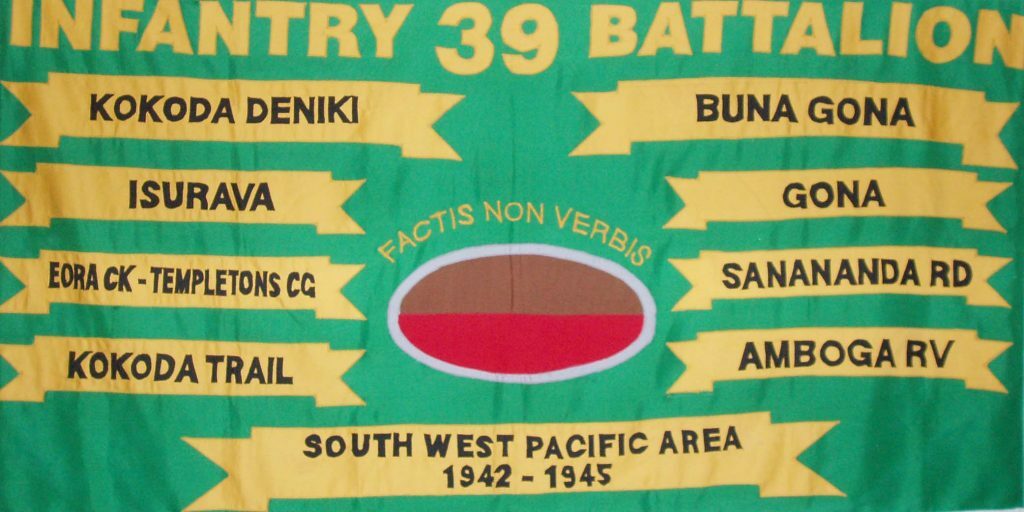
Battle Honours or colours symbolise the spirit of a regiment for they carry the names of battles that commemorate the gallant deeds performed from the time it was raised. This association of Colours with heroic deeds means they are regarded with veneration. In a sense, they are the epitome of the history of the regiment[i].
The full history of a regiment is contained in written records, but these are not portable in a convenient form. On the other hand the Colours, emblazoned with distinction for long and honourable service, are something in the nature of a silken history, the sight of which creates a feeling of pride in soldiers and ex-soldiers.[ii]
This is a significance that commentators and bureaucrats who have never worn the uniform will never fully comprehend.
The Australian War Memorial (AWM)
The Australian War Memorial is the official custodian of our military history. The Memorial has honoured the battle honour of the 10 Australian battalions by naming the Second World War Galleries ‘Kokoda Trail’.
According to the Memorial’s website the ‘Kokoda Trail Campaign’ was fought over ‘a path that linked Owers Corner, approximately 40 km north-east of Port Moresby, and the small village of Wairopi, on the northern side of the Owen Stanley mountain range. From Wairopi, a crossing point on the Kumusi River, the Trail was connected to the settlements of Buna, Gona and Sanananda on the north coast. Its name was derived from the village of Kokoda that stood on the southern side of the main range and was the site of the only airfield between Port Moresby and the north coast[i].
For trekkers the Kokoda Trail lies between Owers Corner and Kokoda.
In response to the debate over the official name of the Kokoda Trail, Australian War Memorial historian, Garth Pratten surveyed the Memorial’s collection of published histories of all the major units involved in the Owen Stanley and Beachhead campaigns in 1997. Pratten found that of the 28 published histories 19 used ‘Kokoda Trail and 9 used ‘Kokoda Track’ – a majority of 2:1 in favour of ‘Trail’.[ii]
Pratten noted that ‘these histories were usually written, edited, or published by men who had participated in the campaign’.[iii]
It is ironic that 80 years on we now have city-based academics, commentators, bureaucrats and politicians who have never worn the uniform deem themselves to be more of an authority on the issue than those who saw active service in the Kokoda campaign.
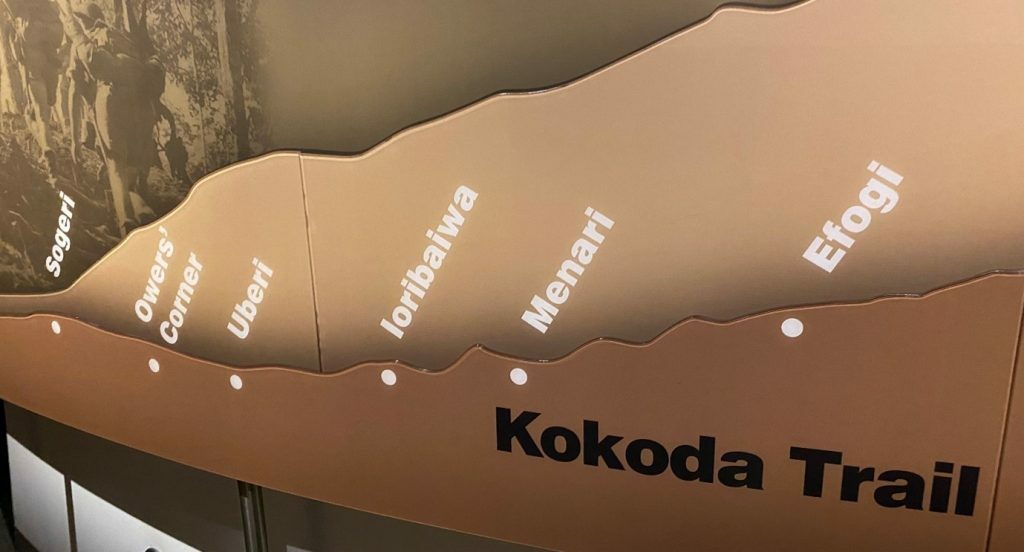
The Returned Services League of Australia (RSL)
The RSL is the largest ex-service representative body in Australia. They accepted ‘Kokoda Trail’ as the official title after the battle honour was awarded in 1958.
A motion by the NSW Branch of the league to have the Kokoda Trail renamed ‘Kokoda Track’ was defeated at the RSL National Congress held in Dubbo on 14-15 September 2010.[i]
Department of Veterans Affairs (DVA)
DVA and DFAT, who have responsibility for the Kokoda Trail in Papua New Guinea, continue to refuse to acknowledge the correct title of the battle honour ‘Kokoda Trail’ and the right of the PNG Government to name their own geographic features.
According to the DVA website[i] ‘the Australian official historian of the Papua New Guinea campaign, Mr Dudley McCarthy, studied this issue more than any other historian. He corresponded with and spoke to many Kokoda veterans, and the fact that he chose ‘Track’ carriers considerable authority’[ii].
If this is true then why do unit histories of the battalions who fought in the Kokoda campaign refer to the Kokoda Trail on a ratio of 2:1?
Dudley McCarthy was a most credible historian however there were many others such as Osmar White (who was on the Trail with the 39th Battalion) and Raymond Paull who were equally credible but had a different view.
The Department of Veterans Affairs believe that McCarthy ‘was certainly influenced by veterans, including senior officers such as Brigadier JE Lloyd, 16th Brigade Commander, who said ‘we on the track referred to it as the Track not trail[iii]‘.
They are obviously unaware that Lieutenant-General Sir Sydney Rowell, former Commander of New Guinea Force during the Kokoda campaign, refers to ‘Kokoda Trail’ in his forward to Raymond Paull’s book, Retreat from Kokoda in 1953[iv]. Major General ‘Tubby’ Allan, Commander of the 7th Division and Lieutenant Colonel Ralph Honner, Commanding Officer of the 39th Battalion at Isurava also refer to ‘Kokoda Trail’.
Captain Bert Kienzle, a plantation owner from Kokoda who trekked across the trail more than any other soldier before, during and after the campaign also has a different view to Brigadier Lloyd. In an address to 40 members of the 39th Battalion on the Kokoda plateau in 1972 Kienzle referred to the track Vs trail debate[v]:
‘We, who fought and saved this nation, PNG, from defeat by a ruthless and determined enemy knew it as the Kokoda Trail not track. . . so I appeal to you and all of those who helped us defend this great country to revere and keep naming it the Kokoda Trail in memory of those great men who fought over it. Lest we forget.’
Departmental officials will go to extraordinary lengths to justify their refusal to accept the official title of the Battle Honour. They have advised that:
‘On 6 March 2008, at a joint press conference in Port Moresby with the then Prime Minister, The Hon Kevin Rudd MP, and the PNG Prime Minister, Sir Michael Somare, the word ‘Track’ was used nine times and there was not mention of the word ‘Trail’. Both Prime Ministers and the reporters asking questions all used the word ‘Track’.
‘In the Australians at War Film Archive, there are 614 references to Kokoda Track and 462 references to Kokoda Trail by the veterans interviewed.’
This could hardly be classified as ‘qualitative’ research and indicates that they have far too much time on their hands!
PAPUA NEW GUINEA
Although the Kokoda Trail is situated within the geographic borders of the sovereign nation of Papua New Guinea their views on the official name have been ignored by Australian academics and armchair historians. Indeed, there is no known record of their views ever being canvassed.
PNG Geographic Place Names Committee
During the establishment of self-government in 1972, PNG government officials from the Department of Lands decided to examine the name of the mail route between Owers Corner and Kokoda with a view to formalising an official name for it. They determined that the name ‘Kokoda Trail’ would be proclaimed. One can assume they would have been influenced by the name of the Battle Honour which had been awarded to their Papuan Infantry Battalion in 1958.
Chief Minister Michael Somare assumed office on 23 June 1972 when the nation achieved self-government as part of the process to independence in 1975. Somare accepted the recommendation of the Place Names Committee and the name ‘Kokoda Trail’ was gazetted four months later on 12 October 1972 (PNG Government Gazette No. 88 of 12 October 1972, page 1362, column 2. Notice 1972/28 of the PNG Place Names Committee refers).
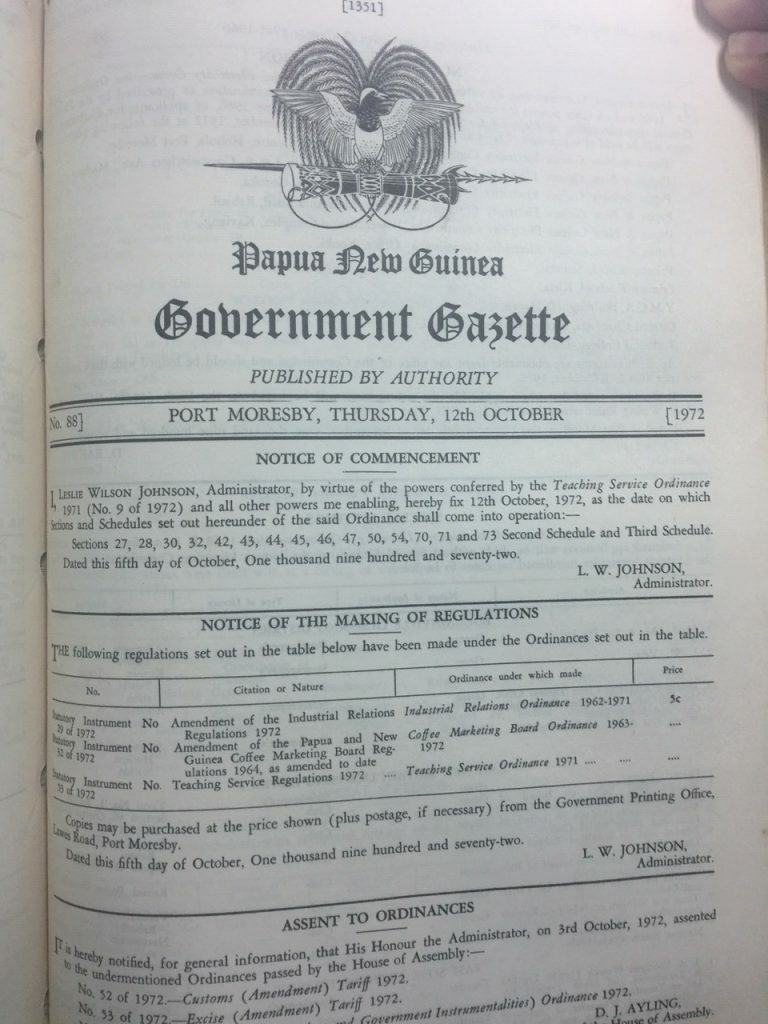 | 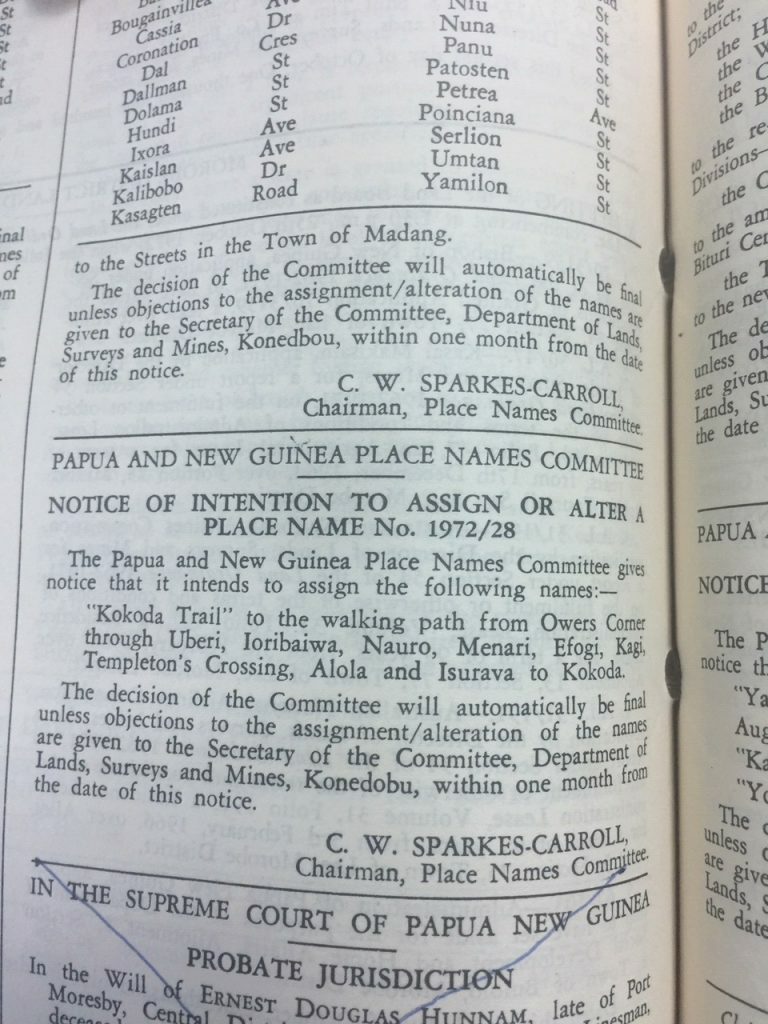 |
In a breathtaking display of patronising arrogance bureaucrats in the Australian Department of Veterans Affairs recently advised that ‘the notice included in the PNG Government Gazette of 12 October 1972 was a declaration of the Australian Administration of Papua and New Guinea and not a declaration of the PNG Government!‘[i] They conveniently ignored the fact that the name ‘Kokoda Trail’ has been on the PNG Government statute books since they obtained independence 40 years ago!
Another patronising historian went further when he declared ‘this was a bureaucratic decision, made under the Australian administration, and therefore doesn’t necessarily reflect the view of the people of PNG’[ii] No references were listed to support this fallacy.
On the contrary, the view of the people of PNG is reflected in their own publications.
Papua New Guinea Publications
The Encyclopaedia of Papua and New Guinea compiled by Peter Ryan in 1972 refers to the ‘Kokoda Trail’. Ryan served with intelligence behind enemy lines in New Guinea during the war. He was decorated with a Military Medal and mentioned in despatches. Ryan was later a Director of Melbourne University Press. His book, ‘Fear Drive My Feet’ has been described as ‘the finest Australian memoir of the war’[i]
Wartime journalist, Osmar White, reported directly from the Kokoda Trail in 1942. Books on his experiences in PNG include Green Armour, Parliament of a Thousand Tribes and Time Now Time Before. These books, along with the ‘Handbook of Papua New Guinea’; ‘Port Moresby, Yesterday and Today’; and ‘Papua New Guinea’ were all published well before the PNG Government gazetted the name ‘Kokoda Trail’.
Professor John Dademo Waiko, a former Member of the PNG National Parliament, academic and respected historian published a ‘Short History of Papua New Guinea in 1993. Professor Waiko is from Oro Province which contains a large section of the Kokoda Trail.
PNG publications which refer to the ‘Kokoda Trail’ include:
- Handbook of Papua New Guinea published in 1954’[i].
- Parliament of a Thousand Tribes. Osmar White. Heinmann: London. 1963. P.125
- Port Moresby: Yesterday and Today. Ian Stuart. Pacific Publications. 1970. P. 362
- Papua New Guinea. Peter Hastings. Angus and Robertson. 1971. P. 53
- Encyclopaedia of Papua and New Guinea. Peter Ryan. Melbourne University Press. 1972. P. 147
- PNG Fact Book. Jackson Rannells and Elesallah Matatier. 1990[ii]
- A Short History of Papua New Guinea. Professor John Dademo Waiko. Oxford University Press. 1993. P271
- Sogeri: The School that helped shape a nation. Lance Taylor. Research Publications. 2002. P337
PNG military history books relating the Papuan Infantry Battalion and the New Guinea Volunteer Rifles which also refer to the ‘Kokoda Trail’ include:
- Green Shadows: A War History of the Papuan Infantry Battalion. G.M.Byrnes. 1989. P. 12
- The New Guinea Volunteer Rifles 1939-1943 – A History. Ian Downs. Pacific Press. 1999. P. 164
- To Find a Path. The Life and Times of the Royal Pacific Islands Regiment. James Sinclair. Boolarong Publications. 1990. P. 143
- The Architect of Kokoda: Bert Kienzle – the Man who made the Kokoda Trail. Robyn Kienzle. Hachette Australia. 2011. P.311
Stuart Hawthorne, author of the most definitive history of the Kokoda Trail[i] (a 30 year research project) recently wrote on the Australian War Memorial blog:
‘Exploration and development of the early parts of the overland route near Port Moresby began about 130 years ago. In this light, the campaign constitutes a very small part of the track’s history (about a third of one percent) yet the importance ascribed to the WW2 period often assumes a considerably high significance. Of course the Kokoda campaign is very important in Australia on many levels but notwithstanding this, I often wonder whether the presumption that our Australian perspective displaces all others and borders on the arrogant’.
These publications span a 70-year period and make a mockery of the statement that the decision of the PNG Government Place Names Committee ‘doesn’t necessarily reflect the view of the people of PNG’.
Official Maps
The Royal Australian Survey Corps published a series of 1:100 000 topographical maps in 1974 (Port Moresby – Efogi – Kokoda). The source data for the maps were wartime aerial photographs, sketch maps and survey patrols. The maps identify the original mail route across the Owen Stanley Ranges which are clearly marked ‘Kokoda Trail’.
The PNG National Mapping Bureau published a ‘Longitudinal Cross Section of the Kokoda Trail’ in 1991. The map was derived from the Department of Works and Supply, Drawing Number A1/100897 dated May 1982 with field verification by 8 Field Survey Squadron in June 1991 and May 1992.
The PNG Department of Lands and Physical Planning produced the following ‘Kokoda Trail Area Map’ of Oro and Central Province in 2002:
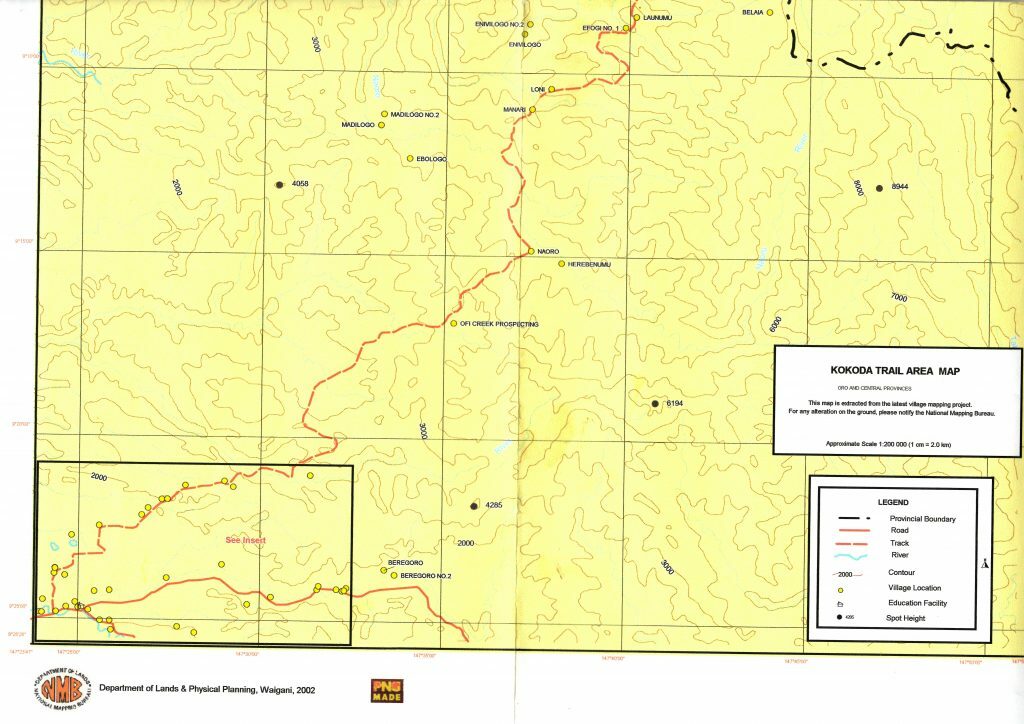
Australian Military History Publications
The following books include the unit histories of the three battalions (2/14th, 2/16th/2/27th) of the 21st Brigade who fought at Isurava, Brigade Hill and Imita Ridge – all refer to ‘Kokoda Trail’. Other distinguished historians including Professor David Horner, Colonel E.G. Keogh and Raymond Paull, refer to the ‘Kokoda Trail’ in the following publications:
- Khaki and Green. Published for the Australian Military Forces by the Australian War Memorial in 1943[i] P.157
- Jungle Warfare. Published for the Australian Military Forces by the Australian War Memorial in 1944[ii] P. 70
- Green Armour. Osmar White. Angus and Robertson. 1945. P. 187
- The Coastwatchers by Eric Felt published in 1946[iii].
- The History of the 2/14th Battalion. W.B. Russell MA B.Ed. 1948
- Blamey. John Hetherington. Cheshire Press. 1954. P174
- Retreat from Kokoda by Raymond Paull published by William Heinemann. 1958. P. 314
- A Thousand Men at War: The Story of the 2/16th Battalion. Malcolm Uren. Trojan Press. 1959. P. 119
- The Brown and Blue Diamond at War: The Story of the 2/27th Battalion. John Burns MM. 2/27th Battalion Association. 1960. P. 105
- The South West Pacific 1941-45. Colonel E.G. Keogh MBE ED[iv]. 1965. P.169
- Crisis of Command. David Horner. Australian National University Press. 1978.
- War Dance: The Story of the 2/3rd Battalion. Ken Clift. P.M. Fowler. 1980. P. 286
- New Guinea 1942-44. Timothy Hall. Methuen Australia. 1981. P.101
- High Command. David Horner. Allen and Unwin. 1982. P. 549
- Recollections of a Regimental Medical Officer. H. D. Steward. Melbourne University Press. 1983. P. 167
- The First at War: The Story of the 2/1st Battalion. EC Givney. Macarthur Press. 1987. P. 261
- The Odd Couple: Blamey and MacArthur at War. Jack Gallaway. University of Queensland Press. 1990. P.266
- Blood and Iron: The Battle for Kokoda 1942. Lex McAulay. Hutchinson Australia. 1991. P. 23
- A Young Man’s War: 37th/52nd Battalion. Ron Blair. 37/52 Battalion Association. 1992. P. 106
- Forever Forward: The History of the 2/31st Battalion. John Laffin. Australian Military History Publication. 1994. P.329
- Damien Parer’s War. Neil McDonald. Thomas C. Lothian. 1994. P. 365
- Salvos with the Forces. Lieutenant Colonel Walter Hull. The Salvation Army. 1995. P. 154
- Inside the War Cabinet. David Horner. Allen and Unwin. 1996 P. 137
- Blamey. David Horner. Allen and Unwin. 1998. P. 674
- The Kokoda Trail: A History. Stuart Hawthorne. Central Queensland University Press. 2003
- Kokoda Commander. Stuart Braga. Oxford University Press. 2004. P. 368
- Strategic Command. David Horner. Allen and Unwin. 2005. P. 441
- The Silent 7th: History of the 7th Australian Division. Mark Johnston. Allen and Unwin. 2005. P. 271
- All the Bull’s Men: 2/2nd Commando Squadron. Cyril Ayris. 2/2 Commando Association. 2006. P. 384
- Wartime: Kokoda Then and Now. Official Magazine of the Australian War Memorial. P. 11
- Hell’s Battlefield: The Australians in New Guinea in WW2. Phillip Bradley. Allen and Unwin. 2012. P. 494
- Kokoda Secret. Susan Ramage. Eora Press. 2014. P. 101
- To Kokoda (Australian Army Campaign Series-14). Nicholas Anderson. Big Sky Publishing. 2014. P. 234
Isurava Memorial
The Department of Veterans Affairs, which refuses to recognise the battle honour or the PNG gazetted name, Kokoda Trail, built a significant memorial at the Isurava battlesite. The historical value of the memorial was besmirched with their insistence that the politically correct name ‘Kokoda Track’ be inscribed into it. The memorial was opened by Prime Ministers’ John Howard and Sir Michael Somare, on 26 August 2002. The secretary of the Department of Veterans Affairs who oversaw the project was later sacked by the Government over his handling of road constructions at Gallipoli. He should have been sacked earlier over his arrogant management of the Isurava project which created issues that continue to fester 18 years later!
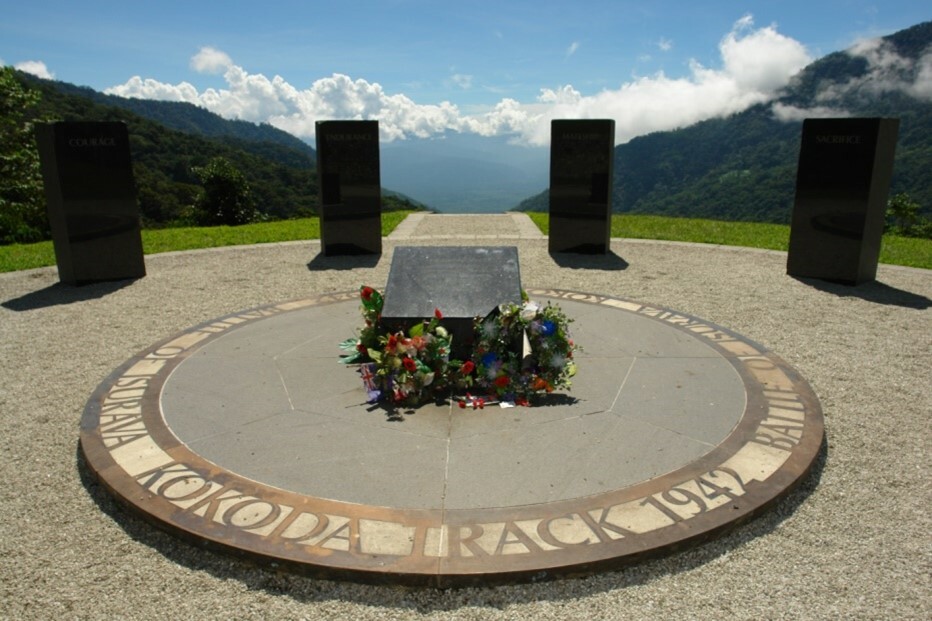 |
WW1 Remembrance Trail on the Western Front
In 2009 the Department of Veterans Affairs was allocated $10 million to develop a Remembrance Trail on the Western Front in France and Belgium for the Centenary of Anzac commemoration period. See http://www.dva.gov.au/commemorations-memorials-and-war-graves/memorials/australian-remembrance-trail-along-western-front
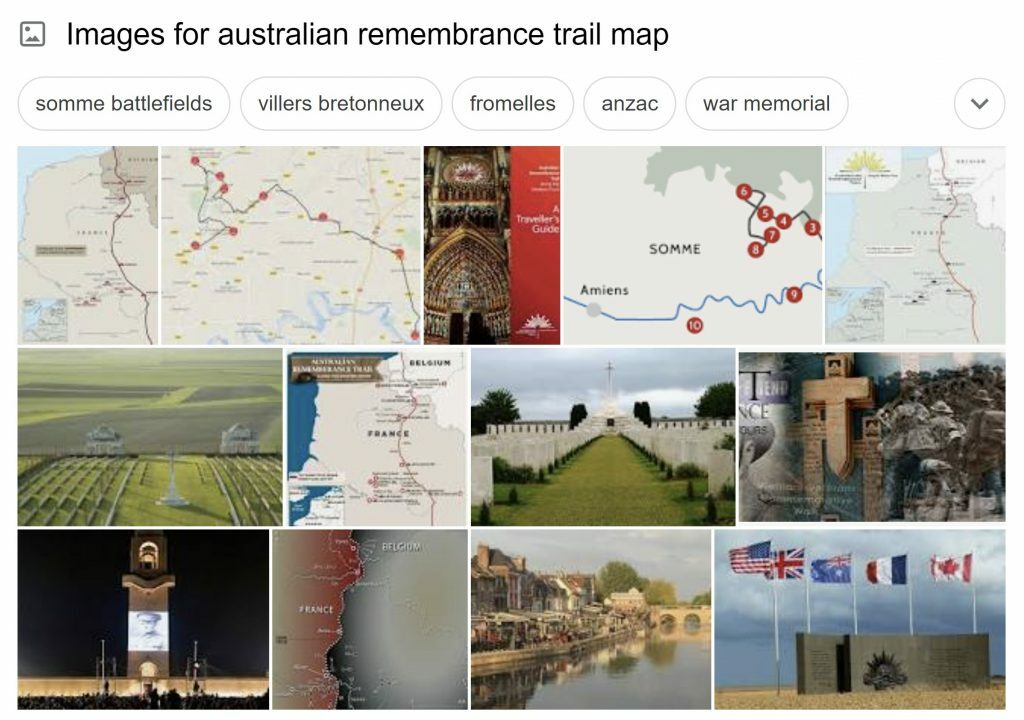 |
The use of the word ‘trail’ in this context creates an interesting paradox for both the Department and the commentariat. There was not a whimper about the ‘Americanisation’ of our WW1 battlefields in France and Belgium. Why did DVA use ‘trail ‘when they could have just as easily used ‘track’ to identify it as Australian? And why did the commentariat not try to mobilise public opinion against that ‘American’ word that does not reflect their interpretation of the ‘language of the Australian bush’?
The decision makes a mockery of their refusal to acknowledge the official name of the Kokoda Trail in Papua New Guinea.
Conclusion
It is not surprising that there were so many variations amongst troops and war correspondents in the terms describing the track/trail/path/dala/front/road between Owers Corner and Kokoda because it didn’t have a name. However, the four books produced in the 1940s (Jungle Warfare, Khaki and Green, Green Armour, the Coastwatchers and History of the 2/14th Battalion) indicate that ‘Kokoda Trail was the adopted term well before the Battles Nomenclature Committee was established. It is therefore easy to understand why the committee adopted the name ‘Kokoda Trail’ for the battle honour.
Subsequent to the awarding of the battle honour ‘Kokoda Trail’ more history books were produced on the Kokoda campaign in the lead-up to self-government in Papua New Guinea. These include the Encyclopaedia of Papua and New Guinea, Blamey, Retreat from Kokoda, a Thousand Men at War, The Brown and Blue Diamond at War and South-West Pacific. All refer to the Kokoda Trail which would have influenced the deliberations of the Papua New Guinea Place Names Committee in choosing ‘Kokoda Trail’ as the official geographic name.
The name ‘Kokoda Trail’ is now officially recognised by:
- The Government of Papua New Guinea
- The RSL of Australia[i]
- The Australian War Memorial Second World War Galleries
It is NOT recognised by DVA or DFAT since the 50th anniversary of the Kokoda campaign in 1992. Both Departments, for reasons known only to the current generations of Government officials, refuse to accept the decision of the Australian Battles Nomenclature Committee or the traditional owners of the land, the Papua New Guinea Government.
Their decision to now use the politically correct term ‘Kokoda Track’ in preference to the official name ‘Kokoda Trail’ is a patronising breach of international protocol towards Papua New Guinea – our closest neighbour, former mandated territory, fellow Commonwealth member and wartime ally.
It is also highly discriminatory against them. If it is OK for the Australian Government to use ‘trail’ in France and Belgium then surely it should be OK to use it in Papua New Guinea – after all they do own the land!
Recommendation
If Canberra based DVA and/or DFAT officials do not like the name ‘Kokoda Trail’ they should follow due process and:
- make a submission to the PNG Government to have them change their gazetted name ‘Kokoda Trail’ to Australia’s politically correct version;
- seek to reconvene a Battles Nomenclature Committee to redefine the battle honour from ‘Kokoda Trail’ to ‘Kokoda Track’ or
- change the name of the WW1 ‘Remembrance Trail’ in France and Belgium to ‘Remembrance Track’.
Until then they should respect the battle honour ‘Kokoda Trail’ and PNGs sovereign right to name their own geographic features!
Em Tasol.
Charlie Lynn
Kokoda Trail Signage
All signage between Owers Corner and Kokoda referred to ‘Kokoda Trail’ prior to the 60th anniversary of the Kokoda campaign in 2002.
There are no signs anywhere along the entire Kokoda Trail which refer to ‘Kokoda Track’
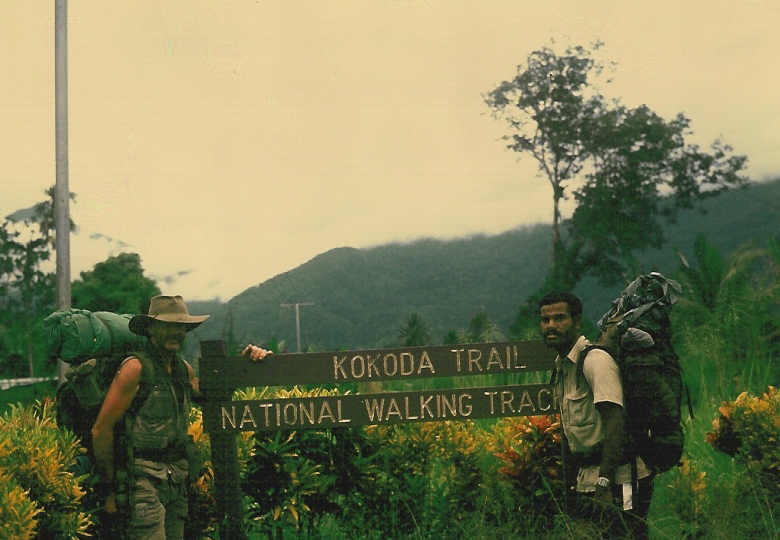
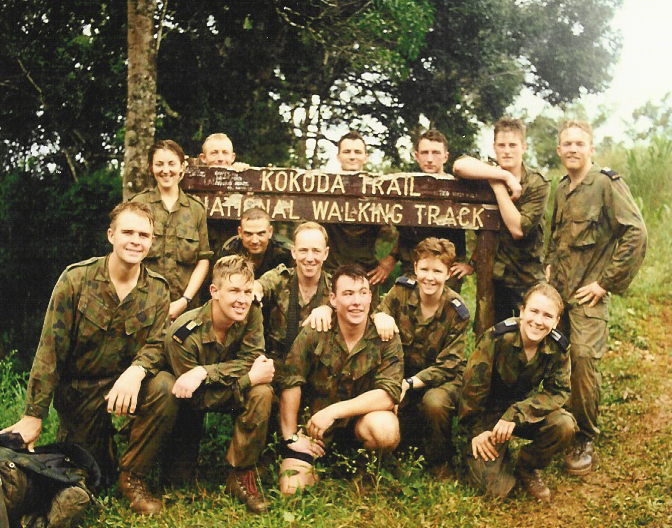
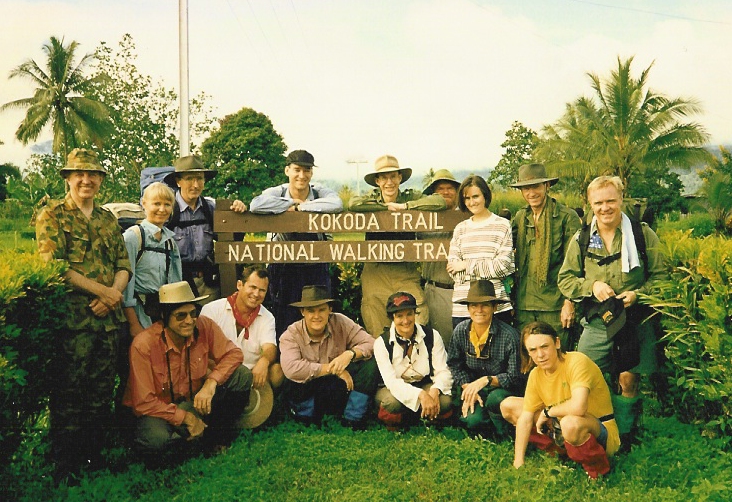

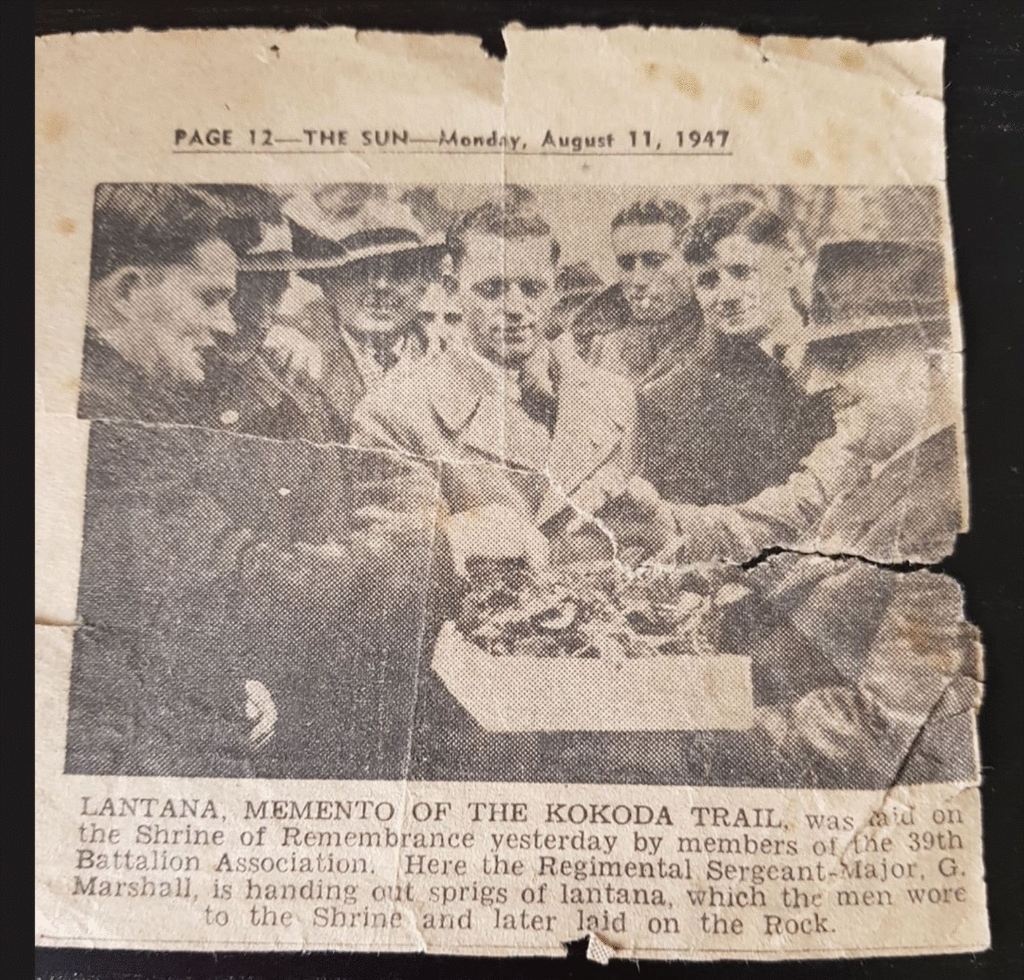
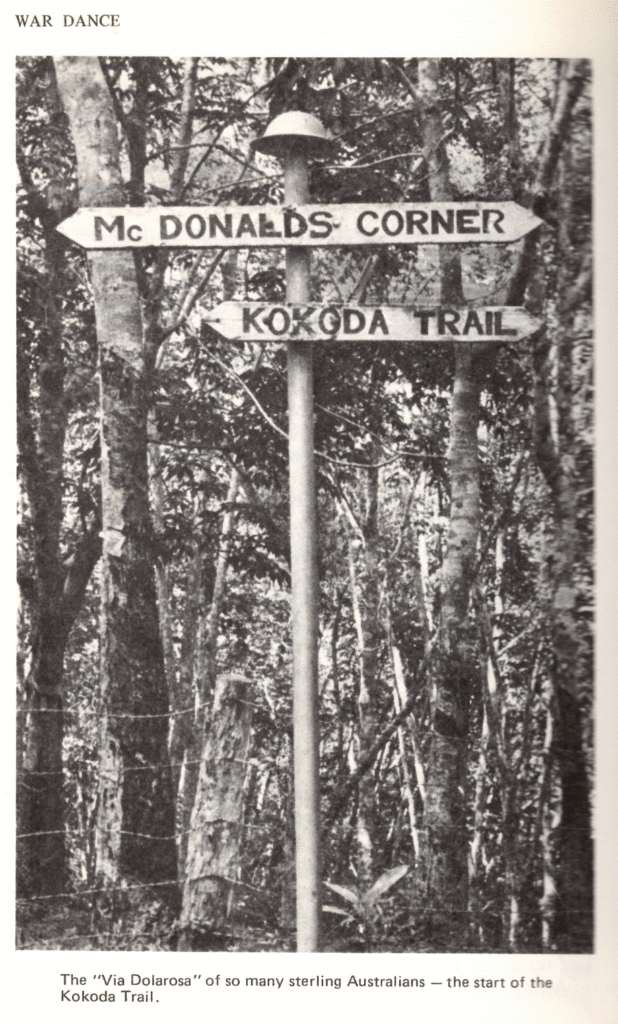
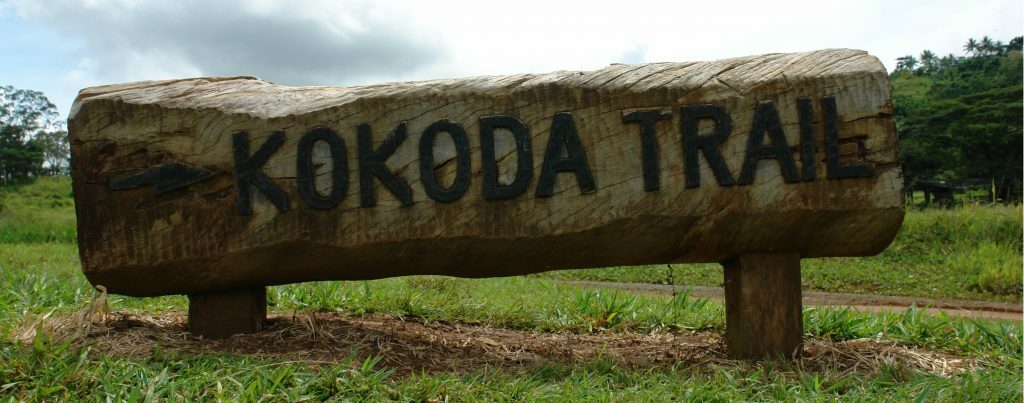
[i] Khaki and Green. Halstead Press. Published in 1943. P157
[ii] Jungle Warfare. Australian War Memorial Canberra. 1944 P.70
[iii] The Coastwatchers by Eric Feldt. The Oxford University Press. P190
[iv] Greyflower Productions 1965 P. 177
[i] Stuart Hawthorne, ‘The Kokoda Trail – A History’ Central Queensland University Press, 2003
[i] Handbook of Papua and New Guinea. Sydney and Melbourne Publishing, 1954. P103
[ii] PNG Fact Book. Jackson Rannells and Elesallah Matatier. Oxford University Press. 1990. P. 260
[i] Peter Ryan’s Fear Drive My Feet remains Australia’s finest war memoir. The Australian. 27 June 2015
[i] Department of Veterans Affairs letter to Charlie Lyn (sic) dated 23 February 2011 advising why they would not use the official title ‘Kokoda Trail.
[ii] Kokoda Spirit. Patrick Lindsay. Hardie Grant Books. 2009. P. 243
In a breathtaking display of patronising arrogance bureaucrats in the Australian Department of Veterans Affairs recently advised that ‘the notice included in the PNG Government Gazette of 12 October 1972 was a declaration of the Australian Administration of Papua and New Guinea and not a declaration of the PNG Government!‘[i] They conveniently ignored the fact that the name ‘Kokoda Trail’ has been on the PNG Government statute books since they obtained independence 40 years ago!
Another patronising historian went further when he declared ‘this was a bureaucratic decision, made under the Australian administration, and therefore doesn’t necessarily reflect the view of the people of PNG’[ii] No references were listed to support this fallacy.
On the contrary, the view of the people of PNG is reflected in their own publications.
[i] Department of Veterans Affairs letter to Charlie Lyn (sic) dated 23 February 2011 advising why they would not use the official title ‘Kokoda Trail.
[ii] Kokoda Spirit. Patrick Lindsay. Hardie Grant Books. 2009. P. 243
[i] DVA website: http://kokoda.commemoration.gov.au/about-the-kokoda-track
[ii] Ibid
[iii] Ibid
[iv] Retreat from Kokoda. Raymond Paull. Heinemann Publishers. 1953. Forward P. xv
[v] The Architect of Kokoda. Robyn Kienzle. Hachette Australia. 2011 P
[i] RSL National Congress Resolution 6.1.2 refers
[i] Australian War Memorial Website https://www.awm.gov.au/military-event/E291/
[ii] Australian War Memorial – Blog Article – The Kokoda ‘Track or Trail’? Karl James. 27 July 2009. P 4
[iii] Ibid. P. 4
[i] Looking Forward Looking Back: Customs and Traditions of the Australian Army. Christopher Jobson. Big Sky Publishing. 2009. P 50
[ii] Ibid P.50
[i] ‘Track’ or ‘Trail’? The Kokoda Debate. Peter Provis. Australian War Memorial. 27 July 2009

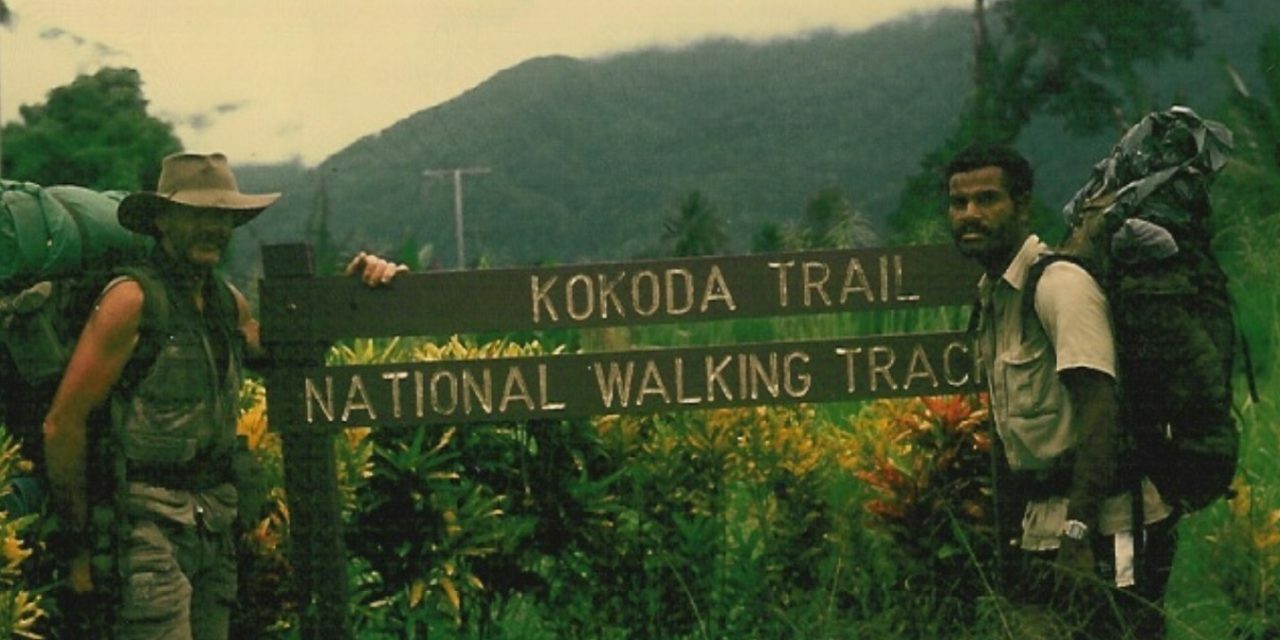
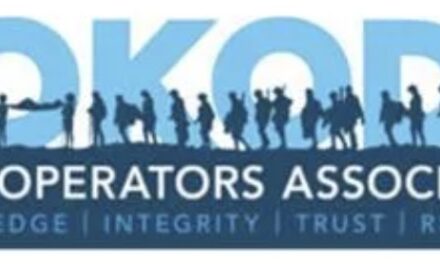
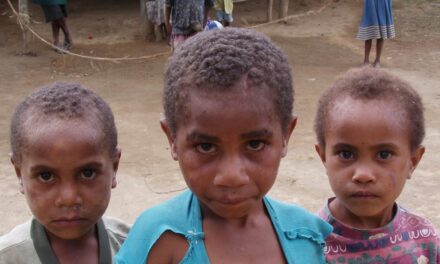


Ever since that battle when I was approximately 5 years old, it was always referred to as the Kokoda Trail which is the correct name. All the huff and bluff by armchair warriors and woke political correct zealots does not and cannot alter history.